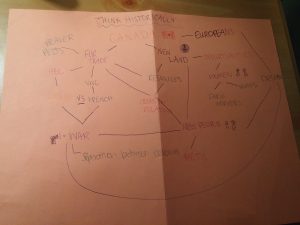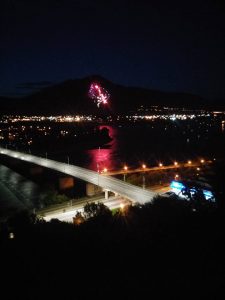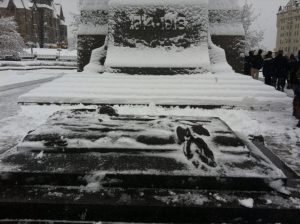 This is the mind map I created in class on what it means to do history and thinking historically. For my mind map, I took a slightly different approach than most people. Overall, I am not a very visual person and I prefer to use words to describe my thoughts rather than pictures. I took the concept of a picture mind map but instead of using pictures, I used only a couple of words or concise phrases to explain my ideas in a simple manner. However, to still give it a visual aspect I used multiple different colours on my mind map to make it more visual and to also make it pop. I would say that my mind map is a fairly accurate representation of what actually goes on in my head when I am thinking historically and trying to connect ideas together.
This is the mind map I created in class on what it means to do history and thinking historically. For my mind map, I took a slightly different approach than most people. Overall, I am not a very visual person and I prefer to use words to describe my thoughts rather than pictures. I took the concept of a picture mind map but instead of using pictures, I used only a couple of words or concise phrases to explain my ideas in a simple manner. However, to still give it a visual aspect I used multiple different colours on my mind map to make it more visual and to also make it pop. I would say that my mind map is a fairly accurate representation of what actually goes on in my head when I am thinking historically and trying to connect ideas together.
Category: Reflections On the Past
My First Reading Log
 The first reading log was the most difficult. Going into writing it, I didn’t have a very good idea of what was expected of me and my writing. Eventually, after writing a couple of the reading logs and getting input from my professor, my reading logs slowly progressed. Feedback I received were things such as creating a road map and organization, which were things I tried to focus on moving into the other reading logs and my assignments. Here is my first reading log as an example:
The first reading log was the most difficult. Going into writing it, I didn’t have a very good idea of what was expected of me and my writing. Eventually, after writing a couple of the reading logs and getting input from my professor, my reading logs slowly progressed. Feedback I received were things such as creating a road map and organization, which were things I tried to focus on moving into the other reading logs and my assignments. Here is my first reading log as an example:
The main thesis of this reading is to introduce the reader to history. Some ideas this reading introduces are historical sources, testing the reliability of sources and exhibiting the different aspects of history. It was written to review the basics to studying history. It is able to shed light on our understanding of the Canadian past by reviewing the basics in order to give the reader insight on how to study history. Some examples of this are demonstrating how perspectives and sources are constantly changing, as well as giving example questions for how to test the reliability of a source. The argument held in this reading is very convincing. It uses multiple examples to support the main thesis and the other arguments provided. The author took some primary sources to support his argument. Mainly, he drew upon paintings and documents to reinforce the topic. This reading contributes to the wider historiography on this topic because it is explaining and going into great detail on the different aspects of history that will be studied throughout the textbook. This reading made me very excited to get to learn more about the different aspects of Canadian history. I found reading about testing sources and the basics of history to be very intriguing. After reading the article for the first time, I was slightly confused and wasn’t sure what message the author was trying to convey. However, after I read it a second time the material made sense and I became very interesting in the reading. Something that I would like to discuss further is the current state of the historical writing in Canada. This is one of the topics I found the most intriguing and yet the most difficult wrap my head around.
Making Reflections
 In this course, reading logs were required to be done weekly and in doing this we analyzed articles from certain events in Pre Confederation Canada. These reading logs, although somewhat difficult at first, really helped me get a good idea on how to make a proper interpretation of the articles. They also helped in my assignments, such as the research paper, the document analysis, and even in other classes.
In this course, reading logs were required to be done weekly and in doing this we analyzed articles from certain events in Pre Confederation Canada. These reading logs, although somewhat difficult at first, really helped me get a good idea on how to make a proper interpretation of the articles. They also helped in my assignments, such as the research paper, the document analysis, and even in other classes.
At first, making reflections on my readings and having to interpret documents was difficult. I did not know how to put my thoughts into words I could use to express what I thought was happening in the articles. It was a new and different kind of learning than what I was used to.
However, as more and more reading logs went by, it became easier to pick out what the article was trying to say and it became easier to make an analysis. The seminars were helpful with this aspect because we were able to discuss the material and make an even more clear interpretation and reflection on the past, and in turn, the articles we were reading.
